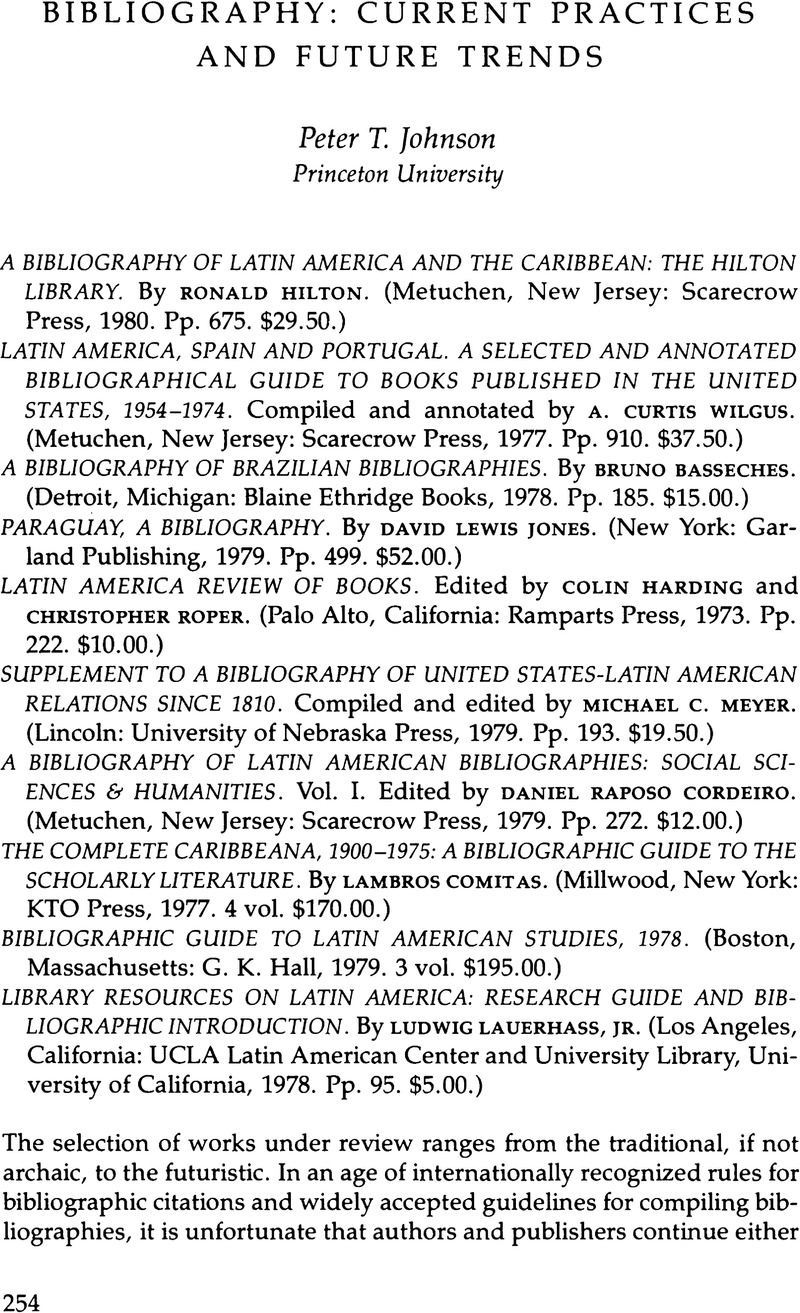No CrossRef data available.
Article contents
Bibliography: Current Practices and Future Trends
Review products
Published online by Cambridge University Press: 24 October 2022
Abstract

- Type
- Review Essays
- Information
- Copyright
- Copyright © 1983 by the University of Texas Press
References
Notes
1. Among the best data bases for Latin American coverage in the social sciences are Public Affairs Information Service, Social Scisearch (Social Sciences Citation Index), Population Bibliography, Economic Abstracts International, Comprehensive Dissertation Abstracts, and Sociological Abstracts. The humanities have only the MLA Bibliography, online from 1976 to the present. For many questions involving agriculture, public health, and related subjects, consult Agricola, MEDLARS/MEDLINE, Commonwealth Agricultural Bureau, and BIOSIS PREVIEWS.
2. When compared to other foreign areas, Latin America fares quite well in the quality and range of bibliographic coverage. Foremost among these sources is the Handbook of Latin American Studies, the single most important publication since 1935. Hapi; Hispanic American Periodicals Index (Los Angeles: UCLA Latin American Center, 1977-) covers periodical articles 1975 to the present in annual volumes. Various Latin American collections have dictionary catalogs published by G. K. Hall, including Florida, Miami, Texas, and Tulane. Substantial Latin American content is in the dictionary catalog of the Bancroft Library and the New York Public Libraries' cumulative catalog 1911–1971.
3. The Dorn work supersedes the 1971 edition with the same title which drew upon Latin America; A Bibliography of Paperback Books, compiled by David H. Andrews (Washington, D.C.: Library of Congress, Hispanic Foundation, 1964) and its subsequent revised edition of 1967.
4. For more detailed coverage of pamphlets and articles from Paraguayan journals, see Carlos F. S. Fernández-Caballero's Aranduká ha kuatiañeé paraguái rembiapocué (Asunción-Washington, D.C.: Paraguay Arandú Books, 1970) and Paraguái tai hũme (Amherst, Mass.: SALALM, 1975). Government documents appear in Rosa Q. Mesa's Paraguay (Ann Arbor, Mich.: Xerox University Microfilms, 1973).
5. Reference is to Rosa Q. Mesa's volumes for various Central American and Caribbean countries which would complete her series Latin American Serial Documents.
6. A partial supplement appears entitled Bibliography of the English-Speaking Caribbean; Books, Articles and Reviews in English from the Arts, Humanities and Social Sciences (Iowa City, Iowa: 1979-) edited by Robert J. Neymeyer of the firm Caribbean Booksellers and since 1980 with the collaboration of Alvona Alleyne of the University of the West Indies Library-Mona. Issued thus far are vols. 1 (1 & 2), 2 (1 & 2) and 3 (1) covering imprints from 1979 through 1981. The format and coverage are quite similar to Comitas. CARINDEX (St. Augustine, Trinidad: Association of Caribbean University, Research and Institutional Libraries, 1977–) biannually indexes over 60 serial publications issued in the Caribbean.
7. Texas. University. Library. Catalog of the Latin American Collection (Boston: G. K. Hall, 1969) and supplements (1971, 1973, 1975, and 1977).
8. One advantage of standardization and acceptance of the Library of Congress as the authority for cataloguing copy is the use without modification of classification numbers by many libraries. Where variation occurs, some libraries include such symbols as a lower-case “x” in part of the number. In the case of the Benson Latin American Collection one cannot distinguish if the number is pure Library of Congress or created at Texas. Furthermore, Texas frequently adjusts the Library of Congress classification for serials and literary authors. Hence, the Bibliographic Guide to Latin American Studies numbers with a BLAC prefix may not be identical with those of other libraries.
9. RLG's RLIN data base has a subject search capacity which is not available in OCLC. Among the major Latin American collections in RLG are those of the University of California-Berkeley, Stanford, Hoover Institution, Minnesota, Yale, New York Public Library, Princeton, and Columbia.




